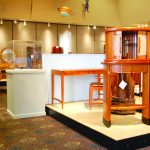We may receive a commission when you use our affiliate links. However, this does not impact our recommendations.
As you will soon learn in your favorite magazine, I am building a chippendale chair. So naturally I’m looking at as many chairs as possible. I’ve had the opportunity to examine reproductions old and new, as well as many fine originals. Speaking of which, there’s a nice display of chairs in Winterthur’s little museum space (not the period rooms). It’s in the gallery downstairs from the Dominy Shop. Don’t miss the story about regionalism there. I like to argue that there’s no such thing as regionalism, or at least that assigning styles to regions is imprecise. You can see evidence for and against in this exhibit.
Anyway, what I’m struck by is how similar chairs are to people. Modern chairs seem to be bigger than period chairs. Sometimes you do see an overall scale change. My friend Paul and I were recently examining the Windsors in the PMoA. They are indeed diminutive compared to many (but not all) modern repros. But that’s not what I’m talking about.
It’s true that Philadelphia chairs tended to be higher than English chairs. Thomas Chippendale set the height of chair backs at 39″ as I recall. Philadelphia chairs are typically over 40″ (it’s a regional thing). But that’s not what I’m talking about either!
What I’m talking about is the wood stretcher. You know, that special machine that makes wood that was cut too short or planed too thin larger. We first learned about it in Junior High wood shop class, remember? We cut a piece of pine too short for the candle stand we were making and we asked our woodshop teacher for help. He said “Oh, you’ll have to put that in the wood stretcher (meaning scrap bin) and get a new piece”.
Maybe the chiding scarred us for life. Maybe the act of wasting material we love just goes against our natures. Maybe woodworkers are naturally risk averse. Whatever the reason, it seems modern woodworkers always want to leave a little extra just in case. The result is often blocky looking furniture, that would work better in the Flintstone’s house.
Look how delicate the ankle is on this chair. Magnificent, isn’t it?
I’ve been practicing carving these legs for months and none of mine look like this. It seems to me I have to work right to my line and be very aggressive with my gouges. But I am inhibited by my shop’s huge wood stretcher.
Adam
Here are some supplies and tools we find essential in our everyday work around the shop. We may receive a commission from sales referred by our links; however, we have carefully selected these products for their usefulness and quality.








This is my life. It’s me. "I cut it three times, and it’s still too short."
To get this kind of work, it can only be dome by a artist but they are not born any more.
The Picture is EXCELENT!
Guys, May I suggest an exercise? take a scrap board large enough to sit on, take 4 pieces of 3/4 by 3/4 by 17 inches scrap wood, and nail the seat board to the four legs. Sit on it. I am almost 250 pounds, and this supports me quite nicely, but do the exercise so your hindbrain believes the forebrain. Then take a look at your leg pattern – there is certainly a 3/4 inch wide strip running up it. Thinks of the rest of the leg as "molding" applied to the leg.
This exercise should quiet your fears of removing too much material.
BTW, we all go through this, and this "ten-minute chair" exercise was one my instructor put the class through. (grin)
Mike
Adam, I know what you mean. I did a practice B&C leg recently working only from bad small pictures and something always didn’t look right about it. The knuckles looked too big, the ball too fat, too many knuckles. I was constantly afraid of taking too much material off. I finally remindeded myself that it was only practice and went back at it and trimmed everything down some more. It looks much better now, though I now wonder if the ankle is too thin. But it was just practice so when I make the next 10 practice pieces, I can change it if I think it necessary. Can’t wait to see yours! By the way, congratulation on your new endeavor!